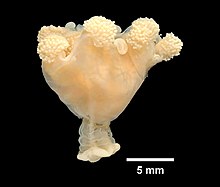
Cnidaria is a phylum under kingdom Animalia containing over 11,000 species of aquatic animals found both in freshwater and marine environments, including jellyfish, hydroids, sea anemone, corals and some of the smallest marine parasites. Their distinguishing features are a decentralized nervous system distributed throughout a gelatinous body and the presence of cnidocytes or cnidoblasts, specialized cells with ejectable flagella used mainly for envenomation and capturing prey. Their bodies consist of mesoglea, a non-living jelly-like substance, sandwiched between two layers of epithelium that are mostly one cell thick.

Medusozoa is a clade in the phylum Cnidaria, and is often considered a subphylum. It includes the classes Hydrozoa, Scyphozoa, Staurozoa and Cubozoa, and possibly the parasitic Polypodiozoa. Medusozoans are distinguished by having a medusa stage in their often complex life cycle, a medusa typically being an umbrella-shaped body with stinging tentacles around the edge. With the exception of some Hydrozoa, all are called jellyfish in their free-swimming medusa phase.

Stauromedusae are the stalked jellyfishes. They are the sole living members of the class Staurozoa and belong to the medusozoa subphylum of Cnidaria. They are unique among medusa jellyfish in that they do not have an alternation of polyp and medusa life cycle phases, but are instead interpreted as an attached medusa stage, with a lifestyle more resembling that of polypoid forms. They have a generally trumpet-shaped body, oriented upside-down in comparison with other jellyfish, with the tentacles projecting upwards, and the stalk located in the centre of the umbrella.

Staurozoa is a class of Medusozoa, jellyfishes and hydrozoans. It has one extant order: Stauromedusae with a total of 50 known species. A fossil group called Conulariida has been proposed as a second order, although this is highly speculative. The extinct order is largely unknown and described as a possibly cnidarian clade of marine life with shell-like structures, the Conulariida. Staurozoans are small animals that live in marine environments, usually attached to seaweeds, rocks, or gravel. They have a large antitropical distribution, a majority found in boreal or polar, near-shore, and shallow waters. Few staurozoans are found in warmer tropical and subtropical water environments of the Atlantic, Indian, and Pacific Ocean basins, but most are known from the Northern Hemisphere. Over the years the number of discovered species has increased, with an estimated 50 species currently recognized. Information on Staurozoa is sparse, and it is one of the least studied groups within Cnidaria. While often neglected, correctly recognizing the characteristics of this class is crucial for understanding cnidarian evolution.
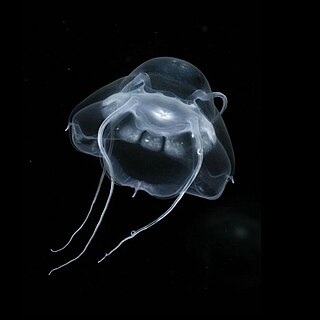
Narcomedusae is an order of hydrozoans in the subclass Trachylinae. Members of this order do not normally have a polyp stage. The medusa has a dome-shaped bell with thin sides. The tentacles are attached above the lobed margin of the bell with usually a gastric pouch above each. There are no bulbs on the tentacles and no radial canals. Narcomedusans are mostly inhabitants of the open sea and deep waters. They can be found in the Mediterranean in large numbers.
Calvadosia cruxmelitensis is a stalked jellyfish which inhabits the intertidal and sublittoral zones of rocky coasts in south-western England and the Atlantic coast of Ireland.

Haliclystus is a genus of stalked jellyfish that contains 11 species and one nomen nudum. It is the largest genus in the order Stauromedusae. Members of this genus are found in the Pacific, Atlantic, Indian, Arctic, and Southern oceans. Two members of this genus, Haliclystus kerguelensis and Haliclystus antarcticus, are found in the Southern hemisphere only. The remaining 9 members are found in the Northern hemisphere only.
Lucernaria janetae is an exceptionally large stalked jellyfish discovered on deep-sea hydrothermal vents on the East Pacific Rise in 2003 and described in 2005.
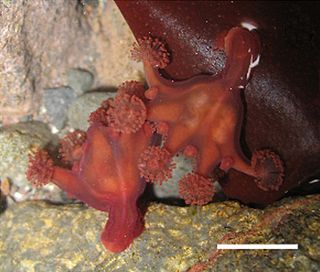
Haliclystus antarcticus is a stalked jellyfish which lives on rocky shore lines in the Southern hemisphere.
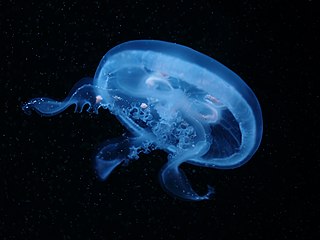
Aurelia labiata is a species of moon jellyfish. It is a cnidarian in the family Ulmaridae. It is typically larger than Aurelia aurita, with individuals document up to 45 cm (18 in). However, much of its size range overlaps with A. aurita, making size an imperfect diagnostic tool. Most Aurelia labiata have a 16-scalloped bell, meaning the bell indents inward at 16 points, a characteristic that also appears in other Aurelia species. Aurelia labiata occurs in the northeastern Pacific Ocean, from the northern coast of California, north to Canada and into Alaska.

Haliclystidae is a family of stalked jellyfish in the order Stauromedusae.
Kyopoda is a genus of stalked jellyfish, It has only one species in the genus, Kyopoda lamberti, and is in turn the only genus in the family Kyopodiidiae.
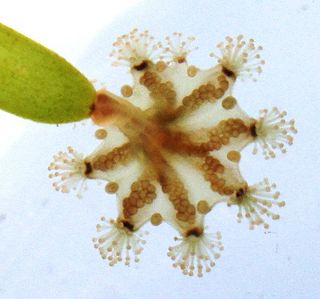
Haliclystus octoradiatus, common name spotted kaleidoscope jellyfish, is a stalked jellyfish in the family Lucernariidae.

Myostaurida is one of two suborders of stalked jellyfishes, the other being Amyostaurida. Species in Myostaurida have—unlike those in Amyostaurida—interradial, longitudinal muscles in their stalks. Myostaurida contains nine genera across four families.

Manania handi is a species of stalked jellyfish found in the Pacific Ocean along the west coast of North America. This species can be found in shallow waters at low tide on soft substrates such as seagrass (Phyllospadix), but the related M. gwilliami have also been recovered at depths of >10 metres. This may reflect that intertidal specimens represent the fringes of a population that is typically more commonly found in the subtidal zone.
Manania gwilliami is a species of stalked jellyfish found in intertidal and subtidal zones on the west coast of North America. The stalk (peduncle) is described as being as long or longer than the calyx; the calyx typically has mottled pigmentation throughout. The name "gwilliami" refers to G.F. Gwilliam who described a number of stauromedusae in the mid-20th century.

Haliclystus sanjuanensis is a species of small (~4 cm) stalked jellyfish found in the Pacific Ocean along the west coast of North America. This species can be found in shallow waters at low tide on soft substrates such as seagrass (Phyllospadix). A variety of colour morphs can be found ranging from yellow-green to red. Haliclystus sanjuanensis was formally described as a distinct species in 2023, following sequence data establishing it as a distinct taxon.
Lipkea ruspoliana is a species of stalked jellyfish. Lipkea species lack tentacles at the end of their bell.

Cephea cephea, also known as the crown jellyfish, or cauliflower jellyfish, is a species of jellyfish in the family Cepheidae. It occurs in the tropical waters of the western Indo-Pacific to Northern Australia. The species was first described by Peter Forsskål in 1775 and originally given the name Medusa cephea. It inhabits the pelagic zone of tropical and sub-tropical waters and is most commonly found in the Indo-West Pacific, eastern Atlantic and the Red Sea. Although this species is among the most venomous jellyfish, it is not harmful to humans and is eaten as a delicacy and used for medical purposes in China and Japan. The species can achieve a diameter of up to 60 cm.
Halimocyathus is a genus of stalked jellyfish in the family Haliclystidae. It is monotypic, containing the sole species Halimocyathus platypus.
